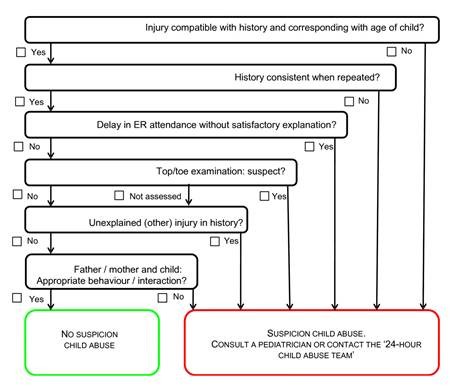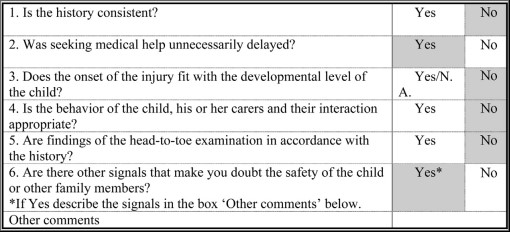Cookie notice
Augeo handles its information very carefully and will never make this information available to third parties.
Systematic screening of children for child abuse in emergency departments is effective and can improve the detection rate of suspected child abuse in combination with ED staff training.
In the online courses offered by Augeo Academy, medical professionals do not learn how to use a specific screening tool; instead, they learn to work with the most commonly used screening questions in well researched screening tools.
For example:
Based on international standards, the Dutch SPUTOVAMO-R is a six-question checklist (see figure 1) with a binary answer format, which is completed for every injured child presented at the ED. This is an example of a screening tool that is widely used in Dutch EDs (Sittig et al., 2014) and aims to unambiguously determine if CAN is suspected (Sittig et al., 2011). Validation of the SPUTOVAMO-R is currently being conducted both within EDs (Sittig et al., 2011) and by general practitioners (GP) (ZonMw project ID: 157004011).
Evidence for the feasibility of this screening procedure can also be found in a prospective study on a very similar screening tool: the so-called escape form (see figure 2; Louwers et al., 2012; Louwers et al., 2013). Analysis of 18,275 children who presented at the ED with injuries showed that although the specificity and sensitivity of the tool leaves room for improvement (0.98 and 0.80 respectively), potentially abused children were significantly more likely to yield an aberrant answer on one (or more) of the six items (OR = 189.8; Louwers et al., 2013). Both studies indicated that a concise checklist can improve detection rates of CAN in EDs (Louwers et al., 2013) when combined with the training of staff and the implementation of systematic guidelines regarding the use of the screening tool (Louwers et al., 2012).

Figure 1

Figure 2